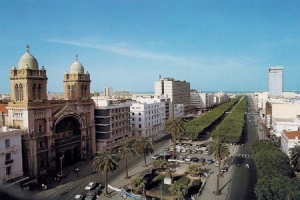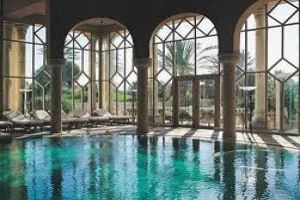SECRETS OF TUNISIA

|

|
|
* By DOMINICK A. MERLE
SIDI BOU SAID, Tunisiaأ¢â‚¬â€This little gem of a country is pretty much of a mystery to most North Americans. Many people don't know where it isأ¢â‚¬â€Europe? Asia?أ¢â‚¬â€and some don't even know what it isأ¢â‚¬â€ An island? A lost continent?
Situated in the middle of the North African coast on the Mediterranean Sea, not far from Sicily, Tunisia is a small country of about 10 million residents, roughly the size of Illinois or Wisconsin. On the map, it looks like it's being squeezed off the African coast into the Mediterranean. But as a bonus, Tunisia is blessed with some of the finest beaches in that part of the world on its north and east coasts. To the south lies the vast Sahara Desert.
Toss in some 3,000-year-old Roman ruins, including the lost city of Carthage and the remains of a 35,000-seat Coliseum that could pass for the one in Rome, sprinkle in a unique blend of African, Islamic, Arabic and European influences, and you have a destination practically begging to be discovered. So why isn't it?
Tourism officials claim that 15,000 Americans visit Tunisia each year, a paltry figure and one that is also probably inflated. I met two during my 10-day stay. Undoubtedly, world terrorism has clamped a lid on tourism in this part of the world. And while Tunisia is a Muslim country like its North African neighbors, I saw no outward signs of anti-Americanism or felt uncomfortable during my stay.
I am always reluctant to make statements like that after a trip, because no one knows where terrorism may strike next, but that was my experience nonetheless. Perhaps its proximity to the European mainland has made Tunisia a more open society. Let's hope it stays that way.
The point remains that long before terrorism became an issue, North Americans visiting the north coast of Africa would usually jump from Morocco to Egypt without so much as a glance down at anything in between.
I saw a great deal of Tunisia in 10 days, at least two-thirds of it. After our arrival in the capital of Tunis, our tour began in the city of Tozeur midway down the country near the Algerian border. Tozeur boasts a massive grove that is said to contain 1.6-million palm trees. This is where Tunisian's best dates come from, called "deglet nour" which translates roughly to "fingers of light."
More than 200 springs gush from beneath the surrounding desert, and several of them are said to be therapeutic. We drove through the desert on roads that were straight as a clothesline. An occasional illustrated sign depicted the warning that it was a favorite camel crossing area. From time to time the vast open desert gave way to a salt-water oasis and this created the sensation of driving down the middle of an ocean.
From Tozeur we headed for the central village of Douz where an annual festival was taking place including camel and horse races and replicas of a Bedouin tent community. We took the customary camel "walks" onto the desert and had lunch in a mock Bedouin setting. Then it was time for the colorful camel and horse races. This was obviously the event of the year for people living in the nearby desert villages.
We continued east to the coastal island of Djerba, connected to the mainland by both a ferry and an old Roman road. Legend has it that Ulysses discovered Djerba. Right or wrong, German, French and British tourists made their own discovery many years ago and flock to the beaches here each summer. It's often referred to as the "Mediterranean Polynesia." It was too cold for swimming while I was there, but I will remember Djerba for a delicious barbecued fish dinner at a restaurant called Haroun. So good I ate two.
From Djerba we headed further south to the city of Tatouine. It wasn't on our agenda, but a bonus tossed in by the tour operator. He wanted to show us a community where Berbers still lived in cave-like dwellings hollowed out from the limestone mountains. We visited one such family of six, a couple and their four children. The interior was modest, but clean and much larger than we expected. Cooking was over an open fire and water was drawn from a nearby spring.
It was a long ride north now to the central city of Kairouan, site of the second largest Casbah or Medina in Tunisia. Besides being a historic and religious center, Kairouan is also known for its crafts. Some of the finest carpets in the world are made here. And also some of the shabbiest. So beware when you enter the numerous shops of the Casbah. Better still, bring along someone who can spot the rip-offs.
There is a world of difference between central Tunisia, with its cave dwellers and old world customs and the coast, with its avant-garde European look. We made that transition an hour's drive from Kairouan to the east coast resort of Sousse, a modern city with an unmistakable Mediterranean look. The area includes Port El Kantaoui, Tunisia's first and largest planned tourism center, and a 300-yacht marina. If you were suddenly dropped here, you might not even know what continent you were on, rather than what country you were in. It's that "touristy."
Heading further north to the seaside resort of Hammamet was even more of a where-are-we transition.
Hammamet has exploded with construction of luxury hotels and condos. This area, known as Cape Bon, is Tunisia's No. l tourist destination for Europeans. Judging from the construction cranes overhead while we were there, it will hold that ranking for quite some time.
We concluded our tour where it began in the capital city of Tunis, by visiting the nearby ruins of Carthage, a city the ancient Romans feared so much that they ordered it to be destroyed. Its soil was even made sterile with salt. Our final spot was the medieval village of Sidi Bou Said, truly a little paradise that looked almost too good to be true.
Sidi Bou Said is an artists' village perched on a hill with a breathtaking view of the Gulf of Tunis. Everything is blue and white here, by law, and the tiny narrow streets seem like they're swept every hour or so. Yet despite its resemblance to a movie set, there is a warmth and charm that somehow manages to emerge through the glitter.
The lady receptionist at my small hotel was a bit like Sidi Bou Said, always smiling, neat as a pin, always friendly, and I often wondered if she were real, too. I may never know, but she was wearing that same smile when I left. A little mystery never hurt anyone.
* (Dominick Merle is a travel writer and consultant based in Montreal)
TIPS
We flew Air France from Montreal to Tunis via Paris, about nine or ten hours of airtime. A number of
other carriers also connect to Tunis with a European stop.
No visas or medical precautions are required for North Americans; only a valid passport.
While the official language is Arabic, French is predominant and spoken by nearly all Tunisians. German, Italian and English are also spoken in the coastal resort areas.
Although Tunisia is generally associated with sunshine, the weather can be chilly from December through April in early mornings and evenings. Bring clothing that can be layered.
For further information contact the Tunisian National Tourism Office at 1253 Avenue McGill College, Montreal, Quebec H3B 2Y5, tel: 514-397-1182, e-mail: tunisinfo@qc.aira.com, or at 1515 Massachusetts Ave. N.W., Washington, D.C. 20005, tel: 202-466-2546, e-mail:tourism@tunisl.tunisiaaccess.com
|
| Back to main page
|
|

Tourist entries slope down by 39%
TUNIS - A noteworthy improvement of hotel occupancy rate was recorded during the last ten days of July, while tourist trade has been marked, since January 2011, by a general decline of entries, overni (08/08/2011)
|
|

UNWTO supporting tourism in Tunisia
UNWTO and the Tunisian Government have signed a partnership agreement under which UNWTO will support the countryأ¢â‚¬â„¢s tourism development. Policy guidance, marketing and training for the tourism w (08/06/2011)
|
|
|
|
Showing 5 news articles
Back
To Top
Casablanca Office / Agents
Mr. Nour-eddine Saoudi
Mrs. Samera Bnalaede
163, rue Taha Hussein, Casablanca-Morroco
Mobile: +21 2 62 047 606
Tel/fax:+212 22 29 90 87
E-mail: itmcasablanca@tcph.org |
الدار البيضاء
السيد نور الدين سعودي
السيدة سميرة بنلعيدي
163 زنقة طه حسين
الدار البيضاء-المملكة المغربية
لتغطية الدول التالية: المغرب، الجزائر، تونس، موريتانيا |

|
|
